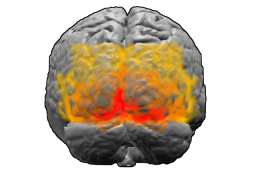
The visual cortex of the brain is the area of the cerebral cortex that processes visual information. It is located in the occipital lobe. Sensory input originating from the eyes travels through the lateral geniculate nucleus in the thalamus and then reaches the visual cortex. The area of the visual cortex that receives the sensory input from the lateral geniculate nucleus is the primary visual cortex, also known as visual area 1 (V1), Brodmann area 17, or the striate cortex. The extrastriate areas consist of visual areas 2, 3, 4, and 5.

In visual perception, an optical illusion is an illusion caused by the visual system and characterized by a visual percept that arguably appears to differ from reality. Illusions come in a wide variety; their categorization is difficult because the underlying cause is often not clear but a classification proposed by Richard Gregory is useful as an orientation. According to that, there are three main classes: physical, physiological, and cognitive illusions, and in each class there are four kinds: Ambiguities, distortions, paradoxes, and fictions. A classical example for a physical distortion would be the apparent bending of a stick half immerged in water; an example for a physiological paradox is the motion aftereffect. An example for a physiological fiction is an afterimage. Three typical cognitive distortions are the Ponzo, Poggendorff, and Müller-Lyer illusion. Physical illusions are caused by the physical environment, e.g. by the optical properties of water. Physiological illusions arise in the eye or the visual pathway, e.g. from the effects of excessive stimulation of a specific receptor type. Cognitive visual illusions are the result of unconscious inferences and are perhaps those most widely known.

The Müller-Lyer illusion is an optical illusion consisting of three stylized arrows. When viewers are asked to place a mark on the figure at the midpoint, they tend to place it more towards the "tail" end. The illusion was devised by Franz Carl Müller-Lyer (1857–1916), a German sociologist, in 1889.

A grid illusion is any kind of grid that deceives a person's vision. The two most common types of grid illusions are the Hermann grid illusion and the scintillating grid illusion.

Depth perception is the ability to perceive distance to objects in the world using the visual system and visual perception. It is a major factor in perceiving the world in three dimensions. Depth perception happens primarily due to stereopsis and accommodation of the eye.
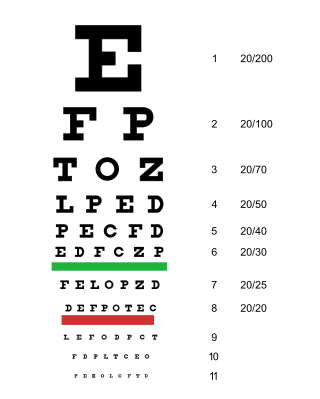
Visual acuity (VA) commonly refers to the clarity of vision, but technically rates an animal's ability to recognize small details with precision. Visual acuity depends on optical and neural factors. Optical factors of the eye influence the sharpness of an image on its retina. Neural factors include the health and functioning of the retina, of the neural pathways to the brain, and of the interpretative faculty of the brain.
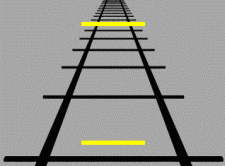
The Ponzo illusion is a geometrical-optical illusion that was first demonstrated by the Italian psychologist Mario Ponzo (1882–1960) in 1913. He suggested that the human mind judges an object's size based on its background. He showed this by drawing two identical lines across a pair of converging lines, similar to railway tracks. The upper line looks longer because we interpret the converging sides according to linear perspective as parallel lines receding into the distance. In this context, we interpret the upper line as though it were farther away, so we see it as longer – a farther object would have to be longer than a nearer one for both to produce retinal images of the same size.
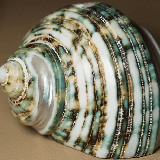
In mathematics, physics, and engineering, spatial frequency is a characteristic of any structure that is periodic across position in space. The spatial frequency is a measure of how often sinusoidal components of the structure repeat per unit of distance.

The flash lag illusion or flash-lag effect is a visual illusion wherein a flash and a moving object that appear in the same location are perceived to be displaced from one another. Several explanations for this simple illusion have been explored in the neuroscience literature.
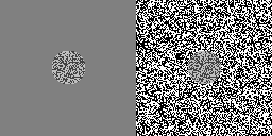
The Chubb illusion is an optical illusion or error in visual perception in which the apparent contrast of an object varies substantially to most viewers depending on its relative contrast to the field on which it is displayed. These visual illusions are of particular interest to researchers because they may provide valuable insights in regard to the workings of human visual systems.
In human visual perception, the visual angle, denoted θ, subtended by a viewed object sometimes looks larger or smaller than its actual value. One approach to this phenomenon posits a subjective correlate to the visual angle: the perceived visual angle or perceived angular size. An optical illusion where the physical and subjective angles differ is then called a visual angle illusion or angular size illusion.
Scene statistics is a discipline within the field of perception. It is concerned with the statistical regularities related to scenes. It is based on the premise that a perceptual system is designed to interpret scenes.
Chronostasis is a type of temporal illusion in which the first impression following the introduction of a new event or task-demand to the brain can appear to be extended in time. For example, chronostasis temporarily occurs when fixating on a target stimulus, immediately following a saccade. This elicits an overestimation in the temporal duration for which that target stimulus was perceived. This effect can extend apparent durations by up to half a second and is consistent with the idea that the visual system models events prior to perception.
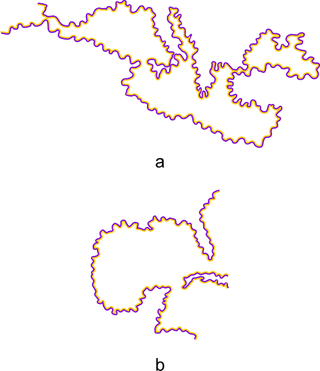
The watercolor illusion, also referred to as the water-color effect, is an optical illusion in which a white area takes on a pale tint of a thin, bright, intensely colored polygon surrounding it if the coloured polygon is itself surrounded by a thin, darker border. The inner and outer borders of watercolor illusion objects often are of complementary colours. The watercolor illusion is best when the inner and outer contours have chromaticities in opposite directions in color space. The most common complementary pair is orange and purple. The watercolor illusion is dependent on the combination of luminance and color contrast of the contour lines in order to have the color spreading effect occur.
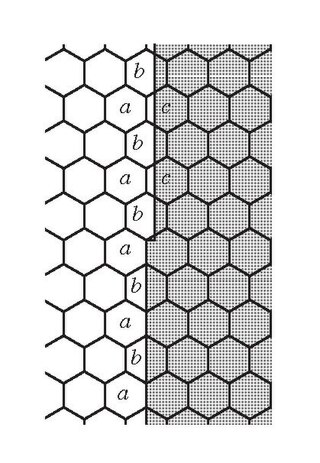
The sharpness of our senses is defined by the finest detail we can discriminate. Visual acuity is measured by the smallest letters that can be distinguished on a chart and is governed by the anatomical spacing of the mosaic of sensory elements on the retina. Yet spatial distinctions can be made on a finer scale still: misalignment of borders can be detected with a precision up to 10 times better than visual acuity, as already shown by Ewald Hering in 1899. This hyperacuity, transcending by far the size limits set by the retinal 'pixels', depends on sophisticated information processing in the brain.
Geometrical-optical illusions are visual illusions, also optical illusions, in which the geometrical properties of what is seen differ from those of the corresponding objects in the visual field.
Oblique effect is the name given to the relative deficiency in perceptual performance for oblique contours as compared to the performance for horizontal or vertical contours.
Visual space is the experience of space by an aware observer. It is the subjective counterpart of the space of physical objects. There is a long history in philosophy, and later psychology of writings describing visual space, and its relationship to the space of physical objects. A partial list would include René Descartes, Immanuel Kant, Hermann von Helmholtz, William James, to name just a few.
Mark Changizi is an American theoretical cognitive scientist. He is known for his research on evolutionary origins of biological and cognitive design, including the "Perceiving the present" hypothesis to understand optical illusions, the "Nature-Harnessing" theory for the origins of writing, speech and music, the skin-signaling hypothesis for the origins of primate red-green vision, and the rain-tread hypothesis for pruney fingers.

The Oppel-Kundt illusion is a geometric optical illusion that occurs when comparing the sizes of filled and unfilled parts of the image. The illusion is named after German physicists Johann Joseph Oppel and August Kundt. It is also known as the "filled-space illusion" or the "illusion of interrupted extent". Depending on the filling elements used, there is a wide variety of graphic implementations of the Oppel-Kundt illusion, which also differ in the magnitude of the visual distortion effects they cause.













